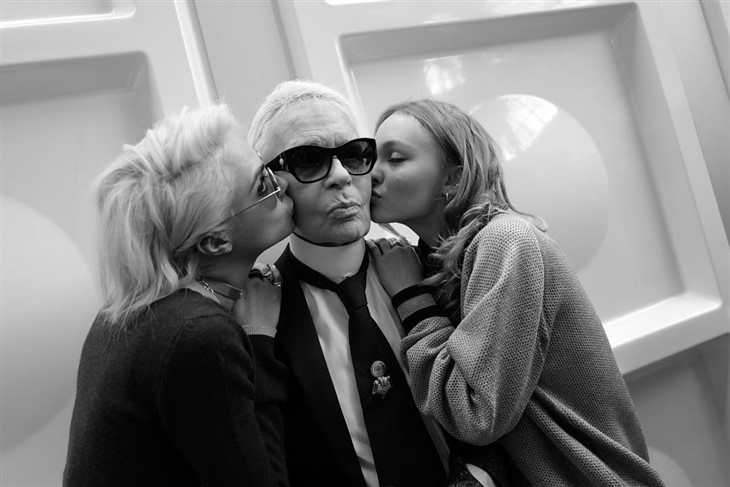
Karl Lagerfeld was one of the most iconic fashion designers of the 21st century. His personal style, creative vision, and entrepreneurial spirit earned him a reputation as one of the industry’s most revered figures. From his beginnings in fashion to his time spent at some of the world’s most iconic fashion brands, Lagerfeld left an indelible mark on the industry, inspiring generations of designers and fashion lovers. With the upcoming Met Gala dedicated to his name and work as well as Disney+ series Kaiser Karl where he will be played by Jared Leto, his name stays the main topic of the fashion events and media.

Personal Life
Karl Lagerfeld‘s early life and beginnings in fashion were shaped by his natural creativity and a lifelong love of fashion. Born in Hamburg, Germany in 1933, Lagerfeld was raised in a privileged family. His father was a businessman who had made his fortune in the condensed milk industry, and his mother was a talented violinist. As a child, Lagerfeld was interested in drawing and fashion. He was a creative and artistic child who spent much of his time sketching designs and creating outfits. His parents recognized his talent and encouraged his interest in fashion, even though they had hoped he would pursue a more conventional career.
In 1952, Lagerfeld moved to Paris to pursue his dream of becoming a fashion designer. He was just 17 years old at the time and had already begun to develop his signature style. Lagerfeld’s early years in Paris were spent working as an assistant to some of the industry’s most well-known designers, including Pierre Balmain and Jean Patou. Working as an assistant allowed Lagerfeld to learn the ins and outs of the fashion industry and hone his skills as a designer. It also gave him the opportunity to observe the work of his mentors and develop his own unique style. Lagerfeld quickly became known for his creative vision and attention to detail, and he soon caught the attention of the fashion world.

Lagerfeld was a private person and kept much of his personal life out of the public eye. He was known to be fiercely independent and rarely spoke about his romantic relationships or family life. However, he did have several long-term romantic relationships throughout his life, including with Jacques de Bascher, a French socialite who passed away in 1989, and his partner of over a decade, Baptiste Giabiconi, a French model who served as one of Lagerfeld’s muses. Lagerfeld was also known for his love of literature, art, and music. He was an avid collector of books and art, and he was known to have an extensive personal library. Lagerfeld was also a talented pianist and was said to enjoy playing classical music in his spare time.
Throughout his life, Lagerfeld was known for his sharp wit and his eccentric sense of style. He was famous for his signature look, which included a white shirt, black sunglasses, and a black suit with a high collar, and he was often seen carrying a fan or a pair of gloves. His eccentricities extended to his personal life as well, with reports of his owning several homes, including a castle in France, and traveling with his beloved cat, Choupette, who even had her own Instagram account. Lagerfeld was a lifelong smoker, and he passed away on February 19, 2019, at the age of 85, reportedly due to complications from pancreatic cancer. His death was mourned by the fashion industry and fans around the world, who recognized him as one of the most influential and visionary designers of his generation.

Fashion Beginnings
Karl Lagerfeld‘s tenure at Chloé, which lasted from 1963 to 1983, was a defining moment in his career and in the history of the fashion industry. When Lagerfeld joined the brand, Chloé was a small and relatively unknown label that primarily produced feminine, romantic dresses. Lagerfeld brought a fresh perspective to the brand, infusing it with a modern, youthful spirit that resonated with women around the world. Under Lagerfeld’s leadership, Chloé became known for its effortless, bohemian style, featuring flowing dresses, soft fabrics, and whimsical prints. Lagerfeld’s designs were both feminine and modern, blending classic and contemporary elements to create a unique aesthetic that was distinctly Chloé.
One of Lagerfeld’s most iconic contributions to Chloé was his introduction of the dolly-bird look, which featured short skirts, fitted tops, and knee-high boots. This look became synonymous with the brand and with the youthful, carefree spirit that Lagerfeld infused into Chloé’s collections. Lagerfeld’s attention to detail was also evident in his use of innovative fabrics and techniques. He experimented with new materials, such as sheer fabrics and knitwear, and incorporated intricate details, such as embroidery and beading, into his designs. This attention to detail helped to elevate Chloé’s collections and establish the brand as a leader in the fashion industry.
During his time at Chloé, Lagerfeld also developed relationships with many of the era’s most famous women, who became his muses and ambassadors for the brand. Women such as Brigitte Bardot, Jackie Kennedy, and Maria Callas all wore Chloé designs, cementing the brand’s reputation as a favorite of stylish and sophisticated women around the world. Today, Chloé remains one of the world’s most iconic fashion brands, thanks in large part to Lagerfeld’s contributions. His tenure at the brand was a defining moment in his career, and his impact on the fashion industry continues to be felt today.

Chanel Era
Karl Lagerfeld‘s work for Chanel was legendary, and he is widely considered to be one of the most influential designers in the history of the brand. Lagerfeld joined Chanel as its creative director in 1983, at a time when the brand was struggling to maintain its relevance in the fashion industry. Under his leadership, Chanel was transformed into one of the most successful and iconic fashion brands in the world. Lagerfeld’s vision for Chanel was centered around its founder, Gabrielle Coco Chanel, and her legacy of innovation and modernity. He was determined to preserve the essence of the brand, while also infusing it with his own creative vision and modern sensibility.
One of the key elements of Lagerfeld’s approach to Chanel was his use of classic, timeless silhouettes, which he updated with modern details and fabrics. He was known for his elegant tailoring, luxurious fabrics, and bold, statement-making accessories, which helped to establish Chanel as a brand synonymous with sophistication and luxury. Lagerfeld was also renowned for his use of bold, graphic prints, which he incorporated into many of his designs for Chanel. He drew inspiration from a variety of sources, including art, architecture, and pop culture, and his designs often featured bold, graphic motifs that were instantly recognizable.

Another hallmark of Lagerfeld’s work for Chanel was his love of accessories. He was known for his innovative use of jewelry, shoes, and handbags, which he used to add a touch of glamour and sophistication to his designs. He also created many iconic Chanel accessories, such as the quilted handbag and the two-tone shoe, which remain popular to this day. Perhaps one of Lagerfeld’s most lasting legacies at Chanel was his ability to create elaborate, over-the-top fashion shows that captured the attention of the fashion world. He transformed the runways into elaborate sets, complete with elaborate backdrops, lighting, and soundscapes, and he often incorporated live performances into his shows. These extravaganzas helped to cement Chanel’s reputation as a brand that was both luxurious and playful, and they remain some of the most memorable moments in the history of fashion.

54 Years of Fendi
Lagerfeld’s work for Fendi was also significant and helped to establish the brand as one of the most successful and innovative in the fashion industry. Lagerfeld was appointed as Fendi’s creative director in 1965, and he remained at the brand until his death in 2019. Lagerfeld’s approach to design at Fendi was characterized by his use of luxurious materials, innovative techniques, and bold, statement-making pieces. He was particularly known for his use of fur, which he incorporated into many of his designs for the brand. He experimented with new techniques, such as laser-cutting and weaving, to create innovative new fur textures and patterns, which helped to establish Fendi as a leader in the fur industry.
Lagerfeld was also known for his use of bold, graphic motifs, which he incorporated into many of his designs for Fendi. He drew inspiration from a variety of sources, including art, architecture, and pop culture, and his designs often featured bold, graphic patterns that were instantly recognizable. One of Lagerfeld’s most iconic contributions to Fendi was his creation of the brand’s signature FF logo, which he designed in 1965. The logo became synonymous with the brand and has remained a staple of Fendi’s designs ever since. Another hallmark of Lagerfeld’s work at Fendi was his ability to collaborate with other designers and artists. He worked with a number of famous artists and designers, including Rei Kawakubo, Silvia Venturini Fendi, and Karl Lagerfeld himself, to create innovative new designs and collections. His work at the brand helped to establish its reputation for luxurious materials, innovative techniques, and bold, statement-making designs, and his impact on the fashion industry continues to be felt today.

Karl Lagerfeld
In addition to his work at Chanel and Fendi, Karl Lagerfeld also had his own eponymous fashion label – Karl Lagerfeld the brand, which he founded in 1984. The Karl Lagerfeld brand was established as a separate entity from Chanel and Fendi, and it was intended to showcase Lagerfeld’s personal vision and creative direction. The Karl Lagerfeld label was characterized by its modern, edgy aesthetic, which was a departure from the more traditional, classic designs for which Lagerfeld was known at Chanel and Fendi. The brand was known for its use of bold, graphic prints, luxurious materials, and innovative silhouettes, which helped to establish it as one of the most innovative and exciting brands in the fashion industry.
One of the key elements of the Karl Lagerfeld brand was its focus on street style and youth culture. Lagerfeld was known for his ability to tap into the zeitgeist of the moment, and his designs for his eponymous label often reflected the latest trends and styles in popular culture. The brand was particularly popular with young, fashion-forward consumers, who were drawn to its edgy, modern aesthetic. The Karl Lagerfeld brand also included a range of accessories, including shoes, handbags, and jewelry. These accessories were characterized by their bold, statement-making designs, which helped to establish them as must-have items among fashion enthusiasts.
Over the years, the Karl Lagerfeld brand evolved and expanded, with Lagerfeld himself overseeing its growth and development. The brand continued to be known for its innovative designs and cutting-edge aesthetic, and it remained a favorite among fashion insiders and trendsetters. Following Lagerfeld’s death in 2019, the Karl Lagerfeld brand has continued to operate under the leadership of its new creative director, Hun Kim, who is working to continue Lagerfeld’s legacy of innovation and creativity. The brand remains a testament to Lagerfeld’s singular vision and his impact on the fashion industry.

Muses
Throughout his career, Lagerfeld was known for his ability to identify and nurture talented young models and designers. He had a keen eye for talent and was always on the lookout for fresh new faces. Some of Lagerfeld’s most famous muses include Ines de la Fressange, Claudia Schiffer, Stella Tennant, Cara Delevingne, Lily-Rose Depp and above mentioned Baptiste Giabiconi. Lagerfeld’s muses were not just models, however. He was also known for his close relationships with actresses and other celebrities, many of whom he dressed for red carpet events and other high-profile appearances. Some of Lagerfeld’s most notable celebrity clients and muses included the actresses Diane Kruger and Julianne Moore, as well as the singer Rihanna.
Lagerfeld’s muses were not just inspiring figures, however. They also played a key role in shaping his designs, and many of his most iconic pieces were created in collaboration with these women. Their influence can be seen in everything from the fabrics and silhouettes to the colors and prints that Lagerfeld chose for his collections. Through their collaborations with Lagerfeld, these women helped to shape the fashion industry and establish the designer’s legacy as one of the most influential and visionary figures in fashion history.
Lagerfeld was also known for his close relationships with some of the industry’s most famous celebrities. He was a close friend of both Anna Wintour and Donatella Versace, and he often collaborated with musicians and artists to create iconic fashion moments. Lagerfeld’s collaborations with artists like Jeff Koons, Pharrell Williams, and Lady Gaga helped to cement his status as a cultural icon.

A Line Of Beauty
In May 2023, the Metropolitan Museum of Art in New York City will be hosting its annual Costume Institute exhibition and Met Gala, and this year’s event is set to be a tribute to Karl Lagerfeld. The exhibition, titled Karl Lagerfeld: A Line Of Beauty, will showcase Lagerfeld’s creative vision and his impact on the fashion industry.
The Met Gala is known for its extravagant red carpet looks and celebrity guests, and this year’s event is sure to be no exception. Many fashion insiders are already speculating about what kind of tribute looks we can expect to see on the red carpet. Given Lagerfeld’s iconic personal style, it’s likely that many attendees will be wearing monochrome looks, bold accessories, and perhaps even Lagerfeld-inspired hairstyles. The Met Gala is an important event for the fashion industry, and Lagerfeld’s tribute is sure to be one of the most talked-about moments of the evening. It’s a fitting tribute to a designer who played such an important role in shaping the industry and inspiring generations of designers and fashion lovers.

For many people the news of honoring Karl Lagerfeld with a Met Gala event didn’t sit well, especially due to a lot of controversies surrounding him in his 65 years of being present in the media. While Lagerfeld was known for his innovative designs and theatrical fashion shows, his reputation was tarnished by his controversial opinions on issues such as race, size, and sexual assault. He believed that models should be sample-sized, and he made derogatory comments about women’s bodies, including Heidi Klum and Adele. He also disapproved of the #MeToo movement and allegedly sent flowers to Dominique Strauss-Kahn after he was accused of sexual assault. Despite being a gay man himself, Lagerfeld held negative views on the LGBTQIA+ community, including opposition to gay marriage.
In conclusion, Karl Lagerfeld was undoubtedly a fashion icon who made an indelible mark on the industry with his innovative designs, unparalleled work ethic, and artistic vision. However, his legacy is definitely tarnished by his controversial and often hurtful comments on sensitive issues. Despite this, Lagerfeld’s influence on fashion is undeniable and he will be celebrated throughout the years.
Words by DSCENE Digital Editor Maja Vuckovic



















